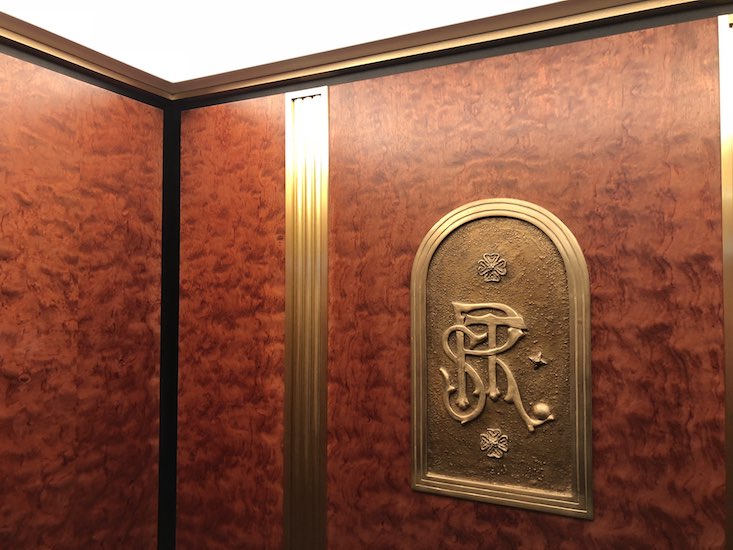Front Passenger Elevators Project Completed
This extensive replacement program for the three St. Regis passenger elevators began over two years ago, in May of 2017. It began with a thorough evaluation of needs and objectives, as the shafts were of a fixed constraint, and comparatively on the small size. After bids were solicited and the project awarded to Allrise elevator, work approvals were granted in October 2018, and actual work began on the West Court elevator in May of 2017.

Residents and guests who utilize the new elevators notice the decor first - the tastefully appointed interior harkens back to the building's origins, yet clearly contains a modern, safe and efficient elevator interface. From the marble floor to the trompe l'oeil ceiling, the interior boasts the finest materials: marble, mahogany, and brass. The cabs are completely new. And although the interface panel with buttons for all floors looks familiar, it too, is completely new.
Not all components were replaced however - the following items were re-used:
- Frames
- Car Structures (the platform upon which the new cabs sit)
- Counterwight
- Rails
- Entrance frames and sills
There are important safety features with which you should familiarize yourself, notably the "Alarm" button (sounds alarm bell) and "Help" button (telephones a live person for help).
Alarm button: This is a red button near the bottom of the elevator's interior control panel (that has floor selections). Pressing this button in the red "Alarm" area will sound a local alarm bell in the building. Generally, unless there is a medical emergency, this should be the first button you should use if a need arises. The alarm bell will sound only as long as you press and hold the button. It will not "stick" and continually sound off once you release it. It does not ring anywhere else, and it is not connected to an alarm system or a direct line to a specific office or person. It simply rings a local alarm bell at the St. Regis, so that a St. Regis employee or guard would notice it and come to you, or perhaps call the elevator. The next advancement in "seriousness" is the "Help" button, below.
Help button: The Help button is to call for help to a live person from the elevator. This replaces the handset telephone with a speakerphone. Also new is that it no longer rings to the St. Regis office, but instead to an alarm monitoring company, that monitors 24/7. To utilize this button, press and hold it until it solidly illuminates (approximately 1-2 seconds, longer push than a normal floor button). This means it is in the process of calling the Help monitor company. It may take up to one minute to connect to a human voice that you will eventually hear on a speakerphone arrangement inside the elevator. Once they answer, a small flashing light will illuminate, indicating you have reached someone. At this point, you can describe your issues and they can call the elevator company directly, the St. Regis directly, or 911 if need be. They will automatically know your location (specific court elevator) when you call.

Here are some commonly asked questions (and answers) and facts about the new elevators:
- Are the elevators faster? No - they're the same speed.
- Why aren't they faster? The speed of the elevator is based on how the building was built to accommodate an elevator shaft, the elevators' respective loads, and how deep the pits are beneath the elevators. Because many of these factors could not change, the speed of the elevators had to remain the same: 200 feet per minute.
- 200 feet per minute is 3 1/3 feet per second, or it takes approximately 3 seconds for our elevators to traverse one floor. So, your estimated ride time from the basement up to your floor is (your floor number) times 3 seconds.
- Where's the emergency phone? It's still there, although there is no longer a handset. It has been replaced by a speaker phone. One press of the button on the interface panel calls a monitoring service, and you speak to them through a speakerphone in the panel. (there is also a new feature added that allows management to call into any of the elevators, with the call originating from management)
- There is still a roof exit, although you are asked to not utilize this unless instructed or in case of dire emergency.
- The elevators seem to be "cooler." The new cabs themselves are not actually air conditioned; however improved, more powerful ventilation fans keep them re-circulated with cooler air. Why is the air cooler? Because the mechanical rooms for each elevator are mandated by new code to be temperature controlled - meaning the elevators now suck air-conditioned air from the mechanical room into the cab, delivering a second-generation air handling experience that results in cooler cabs!
The elevators do offer more efficiency, especially in electricity savings. They are controlled by Smartrise microprocessor controllers, which replace the giant rows of mechanical relays that used to clack and click in the elevator machine rooms. (see photo for "after" picture)
Congratulations and thanks to all involved in this significant building upgrade project - from committee members to planners, to Mark, JB and the Security Guards for all the freight elevator rides. And finally, thanks to all the residents, whose patience was tested throughout this long process!




